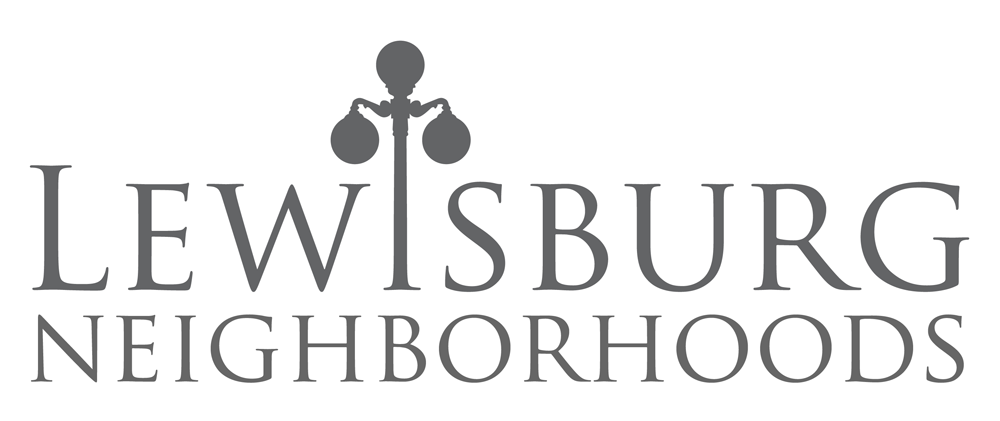People have questions right now and have been wondering why we have not posted much about vaccinations, schools returning in person, the new COVID variants, or local stats. There is a lot of uncertainty right now on all of those counts and we have all along tried to only provide information when we could be clear about it. There just hasn’t been that much definitive info to focus on but that is starting to change. So here is an initial round of reference sites and resources as we move into this next critical stage of our quest to bring the pandemic to an end. (Update: The Time for Patience and Perserverance post has updated information about changes to the phasing plan as of 1/28, but the links in this post remain good for figuring out when and where you may be able to get your vaccination.)
If you follow us on facebook, some of this will look familiar.
We have continued sharing information from the PA Department of Health, Geisinger, Evangelical, and purely online resources like Dear Pandemic, Friendly Neighbor Epidemiologist, and Your Local Epidemiologist (not local to us!) on facebook. That has given us some information about vaccinations, both the state phases, which are still shifting, as well as general parameters and reassurances about the hows and whys of getting vaccinated.
It has also included some very helpful reminders about the limitations of collecting and therefore reading data over the past month with the confounding factor of the holidays. Looking back now it is looking like there was a reduction in some kinds of mobility (regular school and work and day-to-day business) running concurrent with the increase in holiday-related mobility and gathering. There were also significant reductions in the amount of testing done through the end of December. We are now resuming more regular daily activity and more consistent testing. The national stats, with really high numbers of cases and deaths posted at the end of the first week of the year also reflect this dynamic (and as always with the usual dips for weekend data to be expected).
It’s still not entirely clear (our current mantra) how well we did with our mitigation measures over the holiday. We are hoping that we managed as well in December and early January as we did in November, as most of our county case growth was not in the general population following Thanksgiving. The results of Christmas and New Years impacts activity are now in motion. We now expect to see second and third generation infections from people who were infected over the holidays and passed it on, perhaps because they were asymptomatic.
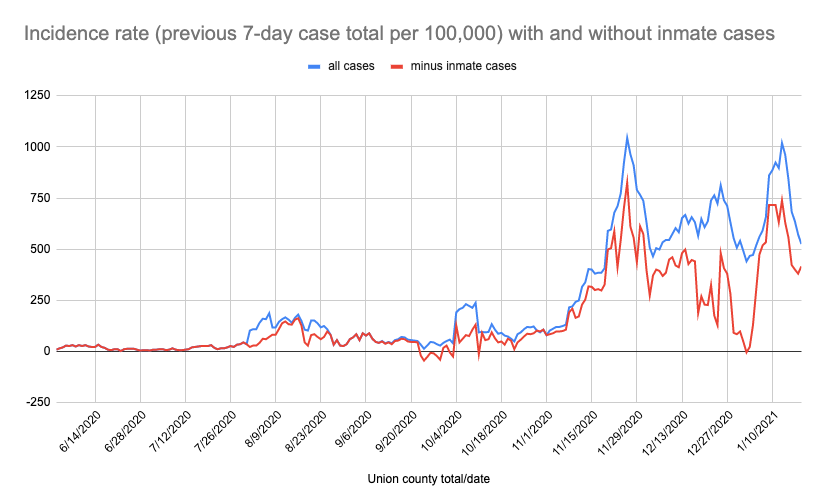
Right now our county stats look like this. Bureau of Prisons reporting tends to lag by a few days, but these rates do not currently appear to be a function of cases in those facilities. As of now, our county incidence rate is around 500 cases per 100k in a week, having been back up to 1000 a week ago.
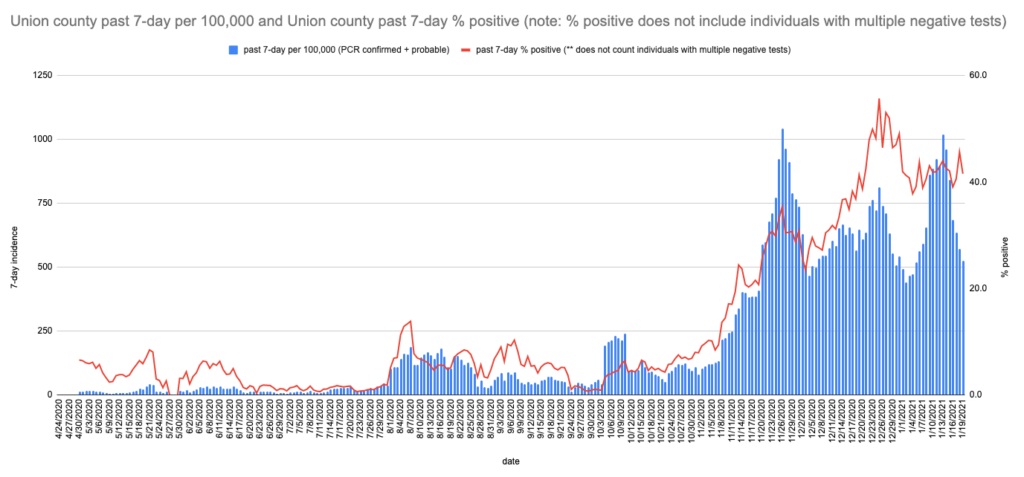
This graph shows the incidence rate as of Tuesday, 1/19. As explained in the past, the percent positivity calculation we are running is based on DOH reported tests and confirmed cases, with duplicate negative tests not showing. The state will not give insight into how they are calculating test positivity, which they release on a weekly basis and they are showing much lower numbers (just over 10%). Evangelical Community Hospital now has a dashboard which gives their own testing stats at around 24% (over 14 days; side note, remember deaths posted there include residents of other counties).
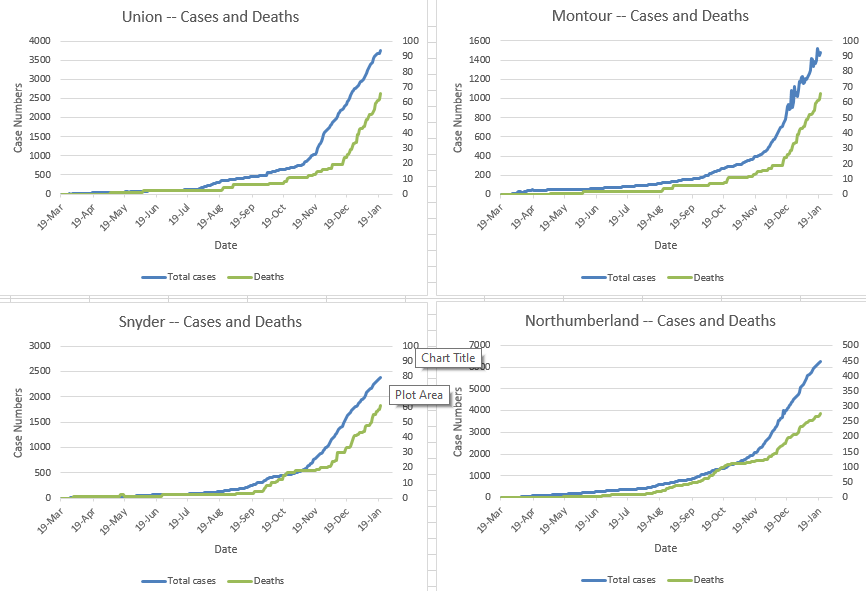
Deaths lag as we have noted repeatedly, but they also track. They are pretty much in lockstep, just on a couple week delay. So until we have enough people vaccinated, as our confirmed cases rise, so do we expect the deaths to in turn. And so for the foreseeable future, we continue to implore everyone to wear masks, keep your distance, wash your hands, avoid indoor gatherings (even with people you are very close to if you do not live with them), and isolate if you are positive, exposed, or symptomatic (_any_ symptoms). Add to that, when you have your opportunity, get vaccinated!
And thereafter STILL keep mitigation up until the community at large is protected. Yes, even after the full course and the two weeks past your second shot, you will for now need to continue to wear a mask and so forth! From those of us at the very end of the vaccination line, thanks!
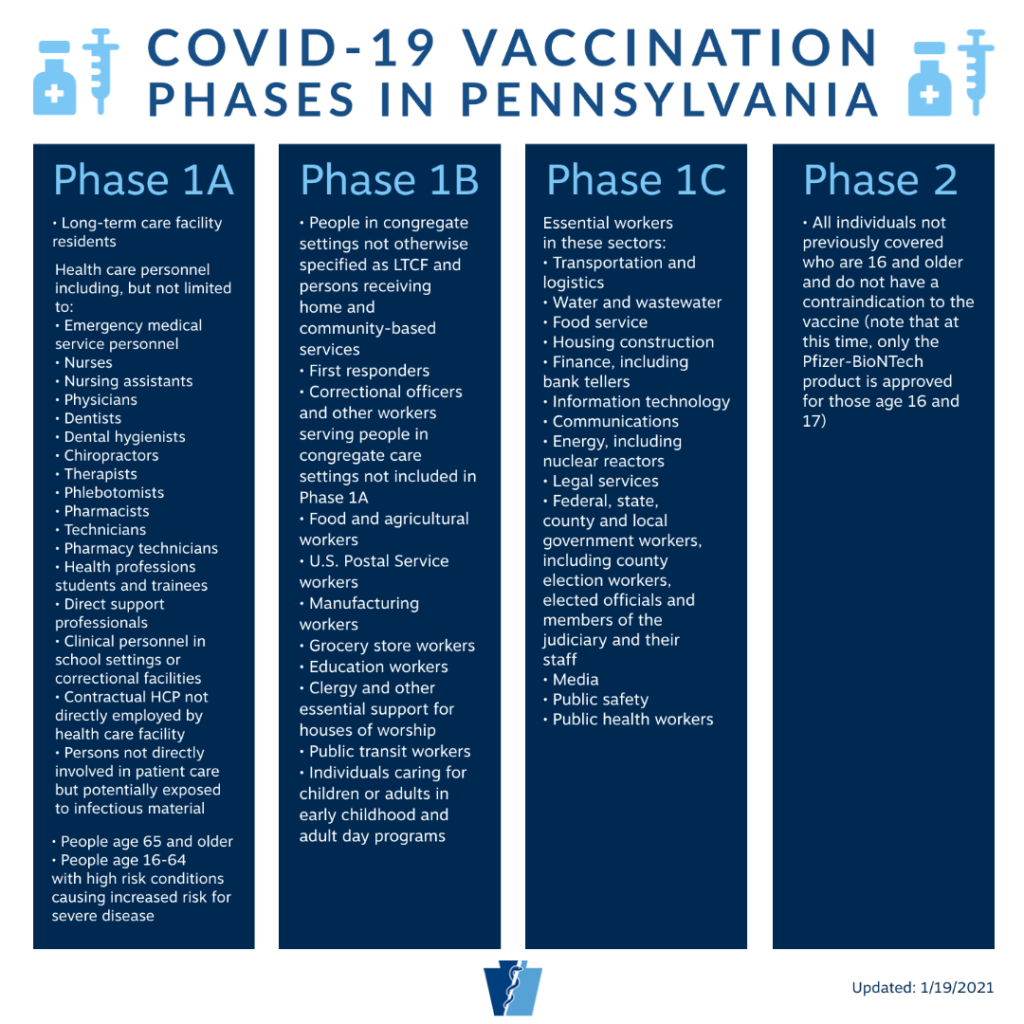
We are currently in Phase 1A of vaccine distribution. Hospitals and some pharmacies have the vaccine and are in the process of vaccinating healthcare workers and long term care facility residents, respectively. The hospitals were asked to distribute some of their allotted doses to unaffiliated healthcare workers, so that has also been happening over the past few weeks. People in that category initially had difficulty figuring out how to sign up to get in that queue, but it is more accessible now. And now we're in the early stage of broader eligibility and are going through the growing pains of that. You can use these links to help figure out whether you meet the new, updated Phase 1A criteria (now including people 65 and up and those 16-64 in high risk categories) and if you're eligible sign up for an initial appointment.
- PA DOH Vaccine Eligibility Quiz
- The PA DOH Vaccine dashboard
- If you know people who do not use computers, the Greater Susquehanna Valley COVID-19 Vaccine Task Force is posting both key local providers' web links AND phone numbers
Remember, this is just where we are right now. This will progress and things will continue to change moving forward. Eventually, we'll all get our turns! Everyone will be expected to make appointments to get their shots, when your turn comes, as opposed to being able to just do a walk-in.
The map pictured is a new feature on that Department of Health Vaccine Information page, offering insight into vaccine providers. In this map, red pins do not yet have the vaccine and grey ones do. Both of the Weis Pharmacies in Union County are now also pending vaccination locations as of 1/20.
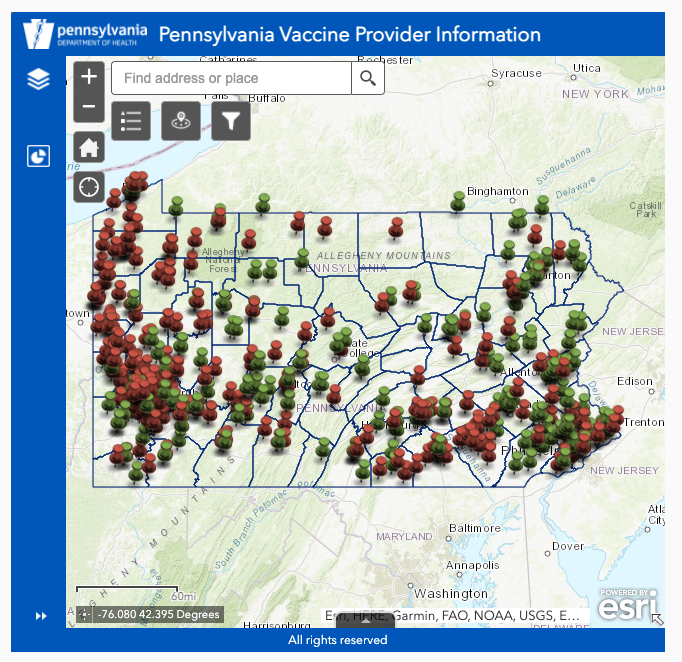
Last week the Center for Rural PA hosted an online panel discussion looking at vaccine distribution in rural parts of the state. It started with a review by now former PA Secretary of Health, Dr. Rachel Levine. She provided background on the vaccine types, the logistics, and the decision-making to date. She also noted that a new set of federal guidelines had just been issued the night before and wasn't yet incorporated and that additional federal changes were expected later that week, not to mention that things would likely change substantially after the 1/20 inauguration...
So this is already somewhat out-of-date but nevertheless here is a rundown of some key points covered in the 90-minute program. It also included discussion among pharmacists, nurses, hospital administrators, and legislators (thanks to a local volunteer for the summary and if you’d like to check out the Williamsport Sun-Gazette’s rendition, it is here).
1) Healthcare providers are finishing up vaccinating people in Phase 1A as we speak. Approximately one half of 1A in PA have received their vaccines (~380K out of ~1M, allowing that not all will take it). However, the PA DOH will now begin adjusting the guidelines. They received new CDC guidelines last night, with more changes anticipated. So, it is expected providers will be urged to move to 1B before administering the second booster shot to 1A and also, possibly, to include anyone over 65 in 1B (as of 1/19, the extension to 65 and older has been confirmed).
2) The rollout for 1B is in the planning stage. Some institutions, such as UPMC and Geisinger, will have online sites for 1B folks to register to be vaccinated. However, registration is not the same as an appointment... it will be mostly an expression of interest and getting into the system in anticipation of when the hospitals receive the vaccine. The state is also looking into having such a website to help match willing folks with providers.
3) The state learns on a Friday how many vaccine doses they will receive for the following week. The doses then dribble in over the week.
4) Do not assume that doses are going to waste based on the gap between doses received and doses administered. The doses received on Monday may not be administered until Thursday; as mentioned above, the allotment doesn't even all arrive in one go; in addition there is a reporting gap of up to two days. As with all of the data about the pandemic, there is a lag. Nothing is in real time.
5) Distribution of shots to those in 1B will be via hospitals, community health centers, and pharmacies. Once the state receives stimulus money, it plans to set up some vaccination sites as well. Eventually it will be appropriate for 1B folk to contact hospitals and pharmacies to learn more, but it is not clear that we are quite at that point. The federal government has contracted specifically with CVS and Walgreens. Many rural areas do not have easy access to those businesses, so independent pharmacies will be involved as well.
6) There is a gap between the willingness of rural and urban populations to receive the vaccine. PEW reported about 52% in rural areas were willing to receive. UPMC reported 42,000 staff vaccinated...80% of their staff in Pittsburgh received shots, 70% in Lock Haven, and 50% in nursing homes run by their organization. Reluctant populations look for guidance from trusted sources. Local leaders can have a significant impact on people's willingness to get vaccinated.
7) The major problem foreseen in inoculating going forward is money, according to UPMC. They will be contracting out for nurses to help administer... the panelist waffled on a question of whether the use of the National Guard would be helpful. UPMC had not done any cost estimates for how much money would be needed. He promised to get those to state legislators.
Video of the webinar is here.
For more detail and key points about vaccination messaging, check out these materials from the deBeaumont Foundation. (This was not referenced in the webinar, but is certainly relevant to the whole discussion!)
- 2-page tip sheet from deBeaumont Foundation
- Background polling data from Frank Luntz
- 1-page tip sheet from NIH (National Institutes of Health)
This vaccine comparison chart was compiled by Your Local Epidemiologist. It is relevant in that there are differences in viability of different vaccine types for rural areas. Dr. Levine pointed out that the ultra ultra-cold storage requirements for the Pfizer vaccine make it less workable, though not impossible in areas without suitable equipment, so we are more likely to see Moderna (and others) rolling out here. For more detailed review of the different vaccines, YLE posts on facebook.

